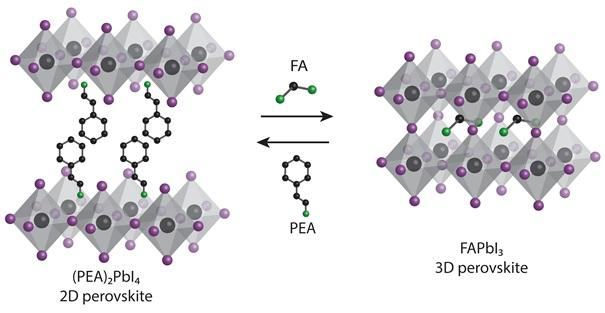
Credit: Loi lab / University of Groningen
Formamidinium lead iodide is a very good material for photovoltaic cells, but getting the correct and stable crystal structure is a challenge. The techniques developed so far have produced rather poor results. However, University of Groningen scientists, led by Professor of Photophysics and Optoelectronics Maria Antonietta Loi, have now cracked it – using a blade and a dipping solution. The results were published in the journal Nanoscale on 15 March 2019.
Formamidinium lead iodide (FAPbI3) is a perovskite, a crystal with a distinctive structure. Perovskites are named after a mineral that has the chemical formula ABX3. In an idealized cubic unit cell, the X position is occupied by anions that form an octahedron with a central cation in the B position while the corners of the cube are occupied by the A position cations (see picture).
Industrial production
‘This formamidinium lead iodide material has very good characteristics, but the A position formamidinium ion causes instability in the structure,’ explains Loi. 3D films made from this material most often turn out to be a mixture of a photoactive and a photoinactive phase, the latter being detrimental to the final application. Loi therefore set her PhD student Sampson Adjokatse to work to find a solution.
After trying different strategies, he found one that worked. ‘And most importantly, one that is scalable and could be used for industrial production,’ says Loi. After all, solar cells must be produced in large panels and it is very important to find a good and cheap technique to do so. Adjokatse started with a different perovskite, in which the formamidinium was replaced by a larger 2 phenylethylammonium molecule, and in doing so formed a 2D perovskite. This material was deposited as a thin film using the ‘doctor-blade’ technique, related to techniques widely used in industrial processes such as printing.
Blade
‘Basically, you spread the material onto a substrate using a blade,’ explains Adjokatse. The blade can be set to produce a film with a thickness of around 500 nanometres, creating the 2D perovskite layer. ‘The important point is that these films are very smooth with large crystalline domains of up to 15 micrometres,’ says Adjokatse. The smooth 2D films based on 2-phenylethylammonium lead iodide were used as a template to produce 3D formamidinium lead iodide films.
This was achieved by dipping the 2D film in a solution containing formamidinium iodide. This resulted in the growth of a 3D film through ‘cation exchange’, where formamidinium took the place of 2 phenylethylammonium. ‘These films show much higher photoluminescence compared to reference 3D formamidinium lead iodide films and show increased stability when exposed to light or moisture,’ says Loi. ‘This means that we now have a method for the production of high-quality films for perovskite solar cells using an industrially scalable technique.’
###
Reference: Sampson Adjokatse, Hong-Hua Fang, Herman Duima and Maria Antonietta Loi : Scalable fabrication of high-quality crystalline and stable FAPbI3 thin films by combining doctor-blade coating and the cation exchange reaction. Nanoscale, online 15 March 2019
Media Contact
Rene Fransen
[email protected]
Original Source
https:/
Related Journal Article
http://dx.



